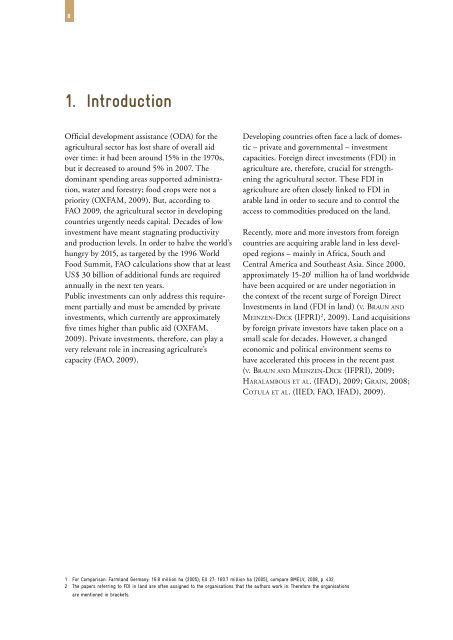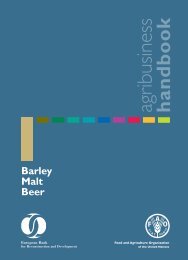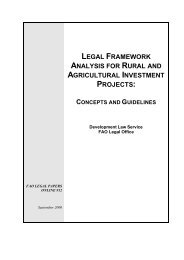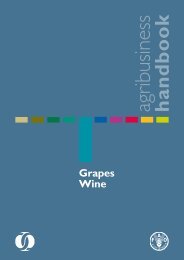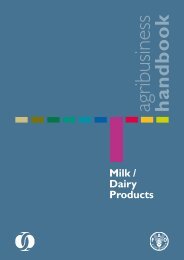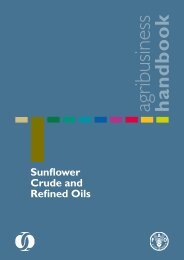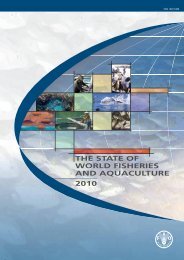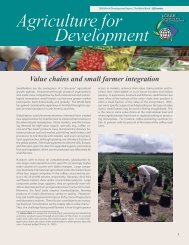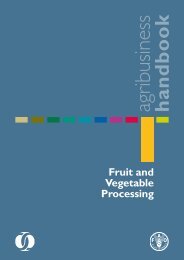Foreign Direct Investment (FDI) in Land in developing countries
Foreign Direct Investment (FDI) in Land in developing countries
Foreign Direct Investment (FDI) in Land in developing countries
- No tags were found...
You also want an ePaper? Increase the reach of your titles
YUMPU automatically turns print PDFs into web optimized ePapers that Google loves.
81. IntroductionOfficial development assistance (ODA) for theagricultural sector has lost share of overall aidover time: it had been around 15% <strong>in</strong> the 1970s,but it decreased to around 5% <strong>in</strong> 2007. Thedom<strong>in</strong>ant spend<strong>in</strong>g areas supported adm<strong>in</strong>istration,water and forestry; food crops were not apriority (OXFAM, 2009). But, accord<strong>in</strong>g toFAO 2009, the agricultural sector <strong>in</strong> develop<strong>in</strong>g<strong>countries</strong> urgently needs capital. Decades of low<strong>in</strong>vestment have meant stagnat<strong>in</strong>g productivityand production levels. In order to halve the world’shungry by 2015, as targeted by the 1996 WorldFood Summit, FAO calculations show that at leastUS$ 30 billion of additional funds are requiredannually <strong>in</strong> the next ten years.Public <strong>in</strong>vestments can only address this requirementpartially and must be amended by private<strong>in</strong>vestments, which currently are approximatelyfive times higher than public aid (OXFAM,2009). Private <strong>in</strong>vestments, therefore, can play avery relevant role <strong>in</strong> <strong>in</strong>creas<strong>in</strong>g agriculture’scapacity (FAO, 2009).Develop<strong>in</strong>g <strong>countries</strong> often face a lack of domestic– private and governmental – <strong>in</strong>vestmentcapacities. <strong>Foreign</strong> direct <strong>in</strong>vestments (<strong>FDI</strong>) <strong>in</strong>agriculture are, therefore, crucial for strengthen<strong>in</strong>gthe agricultural sector. These <strong>FDI</strong> <strong>in</strong>agriculture are often closely l<strong>in</strong>ked to <strong>FDI</strong> <strong>in</strong>arable land <strong>in</strong> order to secure and to control theaccess to commodities produced on the land.Recently, more and more <strong>in</strong>vestors from foreign<strong>countries</strong> are acquir<strong>in</strong>g arable land <strong>in</strong> less developedregions – ma<strong>in</strong>ly <strong>in</strong> Africa, South andCentral America and Southeast Asia. S<strong>in</strong>ce 2000,approximately 15-20 1 million ha of land worldwidehave been acquired or are under negotiation <strong>in</strong>the context of the recent surge of <strong>Foreign</strong> <strong>Direct</strong><strong>Investment</strong>s <strong>in</strong> land (<strong>FDI</strong> <strong>in</strong> land) (v. Braun andMe<strong>in</strong>zen-Dick (IFPRI) 2 , 2009). <strong>Land</strong> acquisitionsby foreign private <strong>in</strong>vestors have taken place on asmall scale for decades. However, a changedeconomic and political environment seems tohave accelerated this process <strong>in</strong> the recent past(v. Braun and Me<strong>in</strong>zen-Dick (IFPRI), 2009;Haralambous et al. (IFAD), 2009; Gra<strong>in</strong>, 2008;Cotula et al. (IIED, FAO, IFAD), 2009).1 For Comparison: Farmland Germany: 16.8 million ha (2005); EU 27: 160.7 million ha (2005), compare BMELV, 2008, p. 432.2 The papers referr<strong>in</strong>g to <strong>FDI</strong> <strong>in</strong> land are often assigned to the organisations that the authors work <strong>in</strong>. Therefore the organisationsare mentioned <strong>in</strong> brackets.


